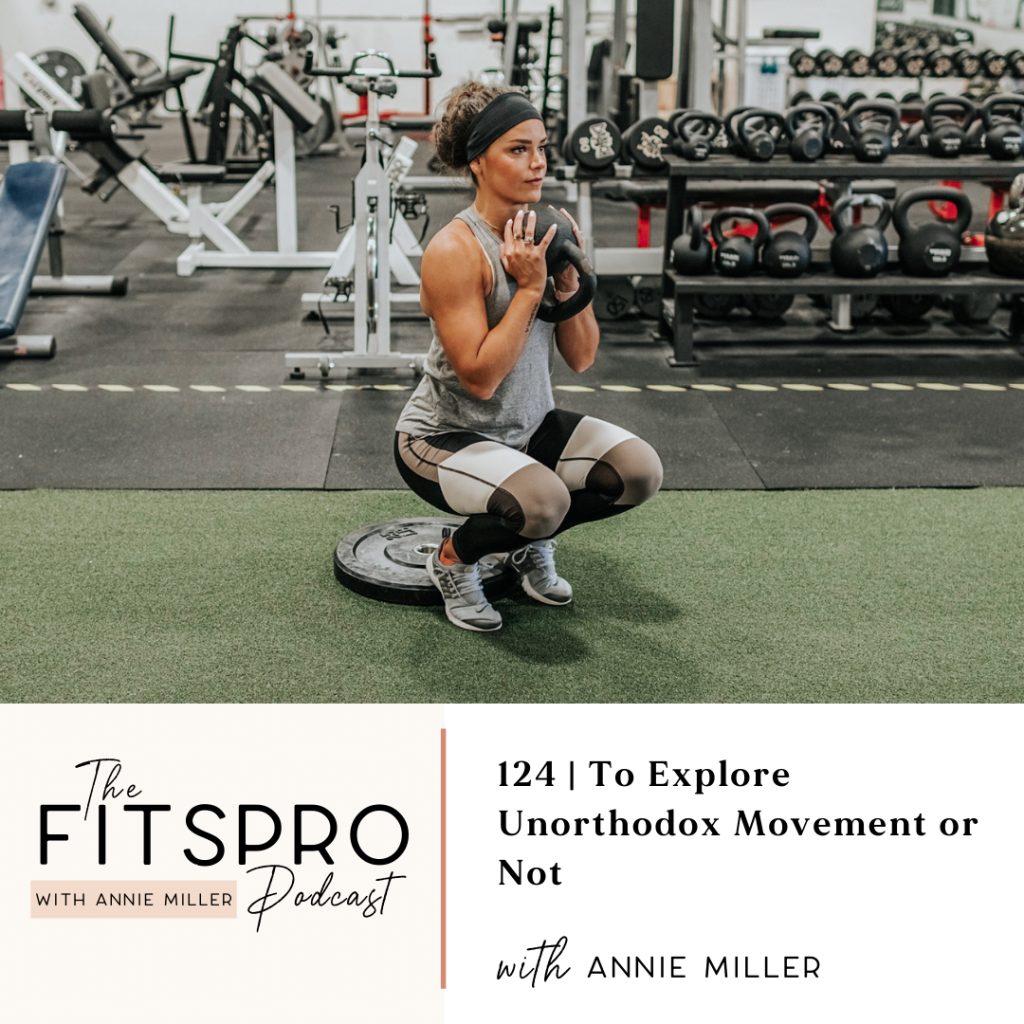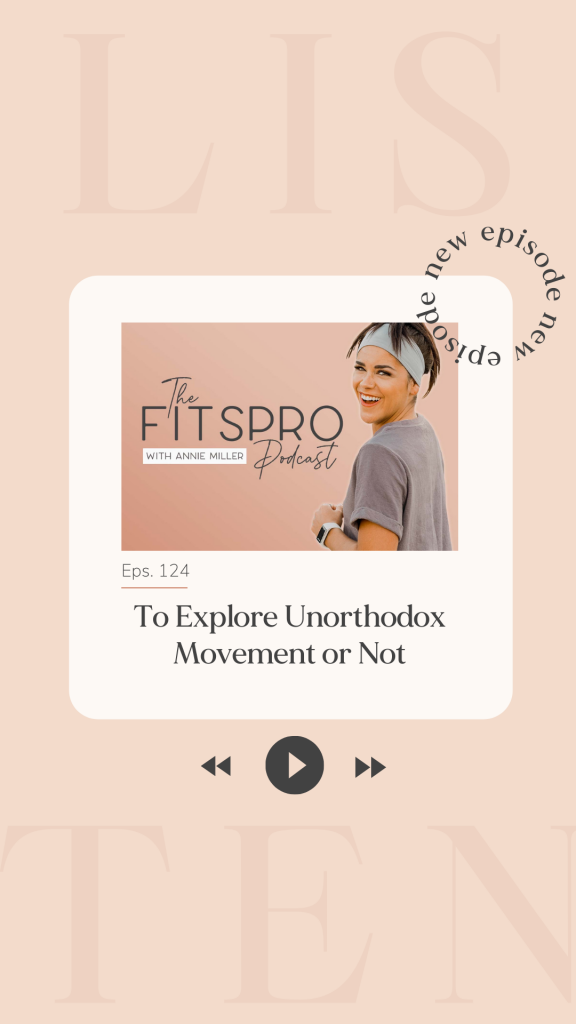the blog
welcome to
looking for something specific? find it here
Podcast: Play in new window | Download (Duration: 27:28 — 37.8MB)
Subscribe: Google Podcasts | RSS

To explore unorthodox movement or not?
Something I get asked a lot online is what I used to support or believe in with health and fitness, that I no longer believe in or support now. I’ve talked about this a bit in other episodes and on Instagram, but I used to be quite the movement elitist.
I’ve also mentioned that I think having more rigid beliefs in any instance when you are new at something is part of a natural process.
We see this often in religion or when someone enters a new industry or philosophy in any area. We tend to start with a more rigid system, and then as we expand and get more comfortable in that space, we are open to questions and gray area. Beyond that gray area comes a new understanding.
Early in my strength and conditioning career, my philosophy was a mix of starting strength, Mark Rippetoe, and Kelly Starrette.
None of those resources or people are bad, it was more so that I took all of that information and thought everyone needed to squat the same, deadlift the same, keep a neutral spine all day every day, and don’t veer away from the basics.
Now, I am still a fan of the basics.
I still aggressively support squat, hinge, push, pull, carry. But I am much more open to squatting patterns, hinging patterns, pushing patterns, pulling patterns, and more unorthodox versions of those patterns.
In the world of training glutes we always hear that we need to train the glutes from all different angles in order to get optimum hypertrophy or increase in cross-sectional area of the glute max, as well as the glute med.
That information is certainly not incorrect, and I ask you how it can be applied to other areas of the body.
People who made me question my movement elitism were doc Jen fit, knees over toe guy, the shirtless dude from move you which I believe now is wealth, and Edo portal.
I’m not saying I support these people or accounts forever and always, I am just saying that at one point in my career or another, these accounts and people specifically made me broaden my view of movement for strength and conditioning.
So in today’s episode, I want to explore all things movement, like bracing with a rounded spine, knees going over toes, strengthening the spinal erectors, and exploring end ranges, in general under load.
Along with topics like the fact that everyone thinks that doing single arm high pulls causes shoulder impingement. Let’s just go ahead and start with that right now. I program high pulls for my clients. And we should start by defining what impingement actually means. According to Oxford Languages, impingement in a medical sense means “a painful condition caused by rubbing or pressure on a tendon, nerve, etc., by adjacent structures.”
That does not need to happen, and should not be happening if performing a the movement of a high pull in the absence of internal rotation and scapular anterior tilting.
If you are performing a high pull correctly, it will only strengthen your shoulder joint and the functionality of that joint. The stronger we can be across different ranges of motion the better. Yes? YES.
A high pull is just another vertical pull. We have pull ups as a vertical pull, and things like lat pull downs. The high pull is simply in the opposite direction of those downward vertical pulling movements. And that is largely why I program it for my clients. To balance the strength we’re building in downward vertical pulling.
If performed correctly, a few things should happen. And I think that’s more-so where things can go wrong – in the execution of the movement.
There are a few, very common ways to do this wrong. If done right, you have external rotation of the humerus at the shoulder, and a posterior tilt of the scapula thanks to your lower traps.
Of course, if you do have pain or pinching that doesn’t seem to go away with playing with that movement pattern, or lowering the weight, please seek a professional in the physio or physical therapy realm. Again, this is not medical advice or exercise instruction. It is a simple conversation. A discussion of topics.
If it wasn’t clear by now, I am now much more for exploring unorthodox movement patterns than I was previously.
So let’s dive into bracing with a neutral spine, spine mobility, and getting into some of those and ranges under load.
A recent systemic review and meta-analysis was done in 2021 on strength training through end ranges vs static stretching for improving range of motion. This is a heavy study to take in as it covers studies from non-trained individuals to trained individuals, under a very wide range of scenarios. So the conclusion was that there is no significant difference between the two – static stretching vs strength training through end ranges but that’s great!
That suggests that 1. we need far more research on the mobility benefits of training end ranges under load. And 2. That we can possibly hit two birds with one stone in using loaded range of motion and strength training to improve one’s range of motion.
Now, there are of course benefits that are individual to each approach. This review was strictly looking at improved range of motion.
We know that injuries can come about from a lack of mobility, lack of flexibility, a strength and balance, or a load versus capacity issue. Now, we are only as mobile as we are flexible. That’s why flexibility and mobility screenings are very useful and important. Someone can be very passively flexible, but have very little control within those ranges. Thus, the lack of mobility.
As the study above demonstrated, working on strength and control in the end ranges, even under load, can be hugely beneficial. That also plays off of the idea that we can gain cross-sectional area, or hypertrophy by accessing more motor units, and as we increase that range of motion we can potentially access more of those motor units because new areas of the muscle are being called upon. Go science. In the study, they reference several scenarios where fascicle length was increased via strength training THROUGH END RANGES. That is the most important part to point out. It seems, with the literature we have so far, that to increase fascicle length, it is less dependent on if time under tension is in eccentric or concentric, and more important that the muscle is loaded across full range of motion.
So, that pretty much covers why I am pro loading mobility and things like the ass to grass split squat from the knees over toes guy. Loading things like Cossack squats, and working on being able to drop all the way to the ground. Things of that sort.
I also want to point out the individual anatomy of each person. Although I am for exploring and ranges, that’s going to look different for everyone. If someone has anteverted hips, they’re likely not doing an ass to grass Cossack squat. And that’s OK.
Now let’s segue into spines.
Because yes I do think that we should be exploring spinal mobility like anything else.
Spines were made to move. The spine is stabilized by muscles. From your deep core like your quadratus lumborum, to the superficial spinal directors. We’ve got a lot going on from your cervical spine down to your hip girdle, but I mainly want to focus on the lumbar spine.
I used to think that we needed to find neutral spine and only brace in neutral spine and that we could never break that position.
While I do still think that people need to be able to locate neutral spine and brace in that position, I also push us to question why someone should never get out of that position especially when lifting.
For sure, in something like a squat, the best force transfer and efficient path is going to be with a neutral spine and the weight over the center of the foot.
But when we broaden the scope a bit and look at strongman competitions and something like an over the shoulder stone roll, a person has to be able to brace and move outside of a neutral spine while remaining uninjured.
If we want to strengthen the glutes and our shoulders from multiple directions and angles, why not do the same with our core?
There is data that suggests that prolonged flexion and extension of the spine while under compression does cause issues and injuries. If you don’t know who Stewart McGill is look him up.
But I am not promoting prolonged flexion and extension while under compression. And I want to make that very clear.
I am simply exploring the idea of Jefferson curls, and Crossbody kettle bell deadlifts, and strengthening the spinal erectors rather than being afraid of using them.
Jefferson curls and Crossbody kettle bell deadlifts involve loaded flexion of the spine. With the cross body deadlifts we also have rotation.
If our core knows nothing other than neutral, we fixate the spine. And the spine was made to move.
I’m not saying let’s forget about the buffer zone when doing deadlifts. If you don’t know what I’m talking about, neutral spine is a buffer zone. So some flexion is likely going to be safe. each person is a bit different. And of course how many deadlifts have been pulled, at what weight, with what level of spinal flexion, is going to make a difference.
All I’m saying is that I think there’s probably benefit in learning to move in different ranges and direction, With intelligent loading or no loading.
For years, certainly when I entered fitness, it was a common cue to tell people to not let their knees go over their toes in squats. I laugh at how young this industry really is sometimes.
They used to tell people to lift their toes in squats. Now we obviously know that planting the big toe and creating a wide base with your foot is how we are going to be able to get the highest force transfer in our squats, and highest stability for sure.
Your knees going over your toes is going to be dependent on the stance of your squat, ankle and hip mobility, the length of your tibia to your femur to your torso and what has to happen to keep the weight over your mid foot.
And generally speaking, it’s not bad for your knees. There are cases I am sure where it is problematic.
Trending now, are cyclist squats, or heel elevated narrow stance squats, often loaded in a goblet position with the weight at the chest. As we know from doing Bulgarian split squats or step ups with a vertical shin versus a positive shin angle, a positive shin angle favors the quads.
If loaded correctly and performed on a proper tempo, strong quads and strong patellar tendons are only going to help the knee.
Our knees are at the mercy of what surrounds them.
If I would’ve seen heel elevated squats years ago, I would’ve said the person needs to work on their ankle mobility and they’re wasting their time. Rather than asking why might they do that, and simply analyzing the movement itself to think about what the movement is targeting.
It’s quite clearly targeting the quads. Plus there’s gonna be a pretty high demand on the core.
Why not? That’s the question I encourage you to ask and myself to ask when we see a movement and have a reaction like “that’s a waste of time, that’s stupid, that causes injury, what are they doing?”
And to be clear, I am not referring to those gym fail videos where people are hanging by 18 bands in the cable machine. I’m talking about an unorthodox version of a somewhat normal pattern that you may have pooh-poohed in the past or still poo poo now.
How might it be applied? What might be the benefit? Why would someone do it? Why would someone not do it? And why do you think those things?
More questions, more curiosity, less elitism. That’s what I’m encouraging.
And hey, maybe in 10 years we know something else and I disagree with something that I’ve said here today. That’s highly likely.
The Olympics got over not that long ago, and it’s one of my favorite times of the year to observe the human body and what it’s capable of. If you watched, you know what I’m talking about. The body can be trained to do so many things and move in so many different ways. So let’s be open to that, shall we?
If you find value here, on The FitsPRO Podcast, then pretty please head over to iTunes, subscribe, rate and review the show. It means the world to me when you spread my message to more humans.
Want more podcasts? Click here to skim the archives.
P.S. Save this value packed episode for later over on Pinterest!
ALL THE LINKS YOU NEED:
Free On Demand Workshop: 3 Steps To Build a Profitable Online Health and Fitness Business
Supplements: Legion Athletics Code ANNIE for 20% off
Skincare: Fré Skincare Code FDBA for at least 15% off
Bags: Vooray Code ANNIE for 20% off
I'm an adventurous introvert from Vancouver, Washington who lives on sleep + "me time." I'm a lover of lifting weights, dinosaurs, real talk and traveling with my husband. I am here to help you move better, lift more, bust the myths of the fitness industry, and inspire you to love the process.
Hey you,
The name's Annie & you're reading my thoughts. Let's get acquainted.
the whole story >
looking for something specific? find it here
THE LINKS BELOW ARE AFFILIATE LINKS
SKIN CARE
Nutrition
brands I love
working against gravity
Fre skin care
favorites
blue light blockers
klassy network
code: fdba saves you 15% off
online TRAINERS
save $50
code: ANNIE saves you 20% off
You love my style, trust my reviews, and want more Annie Miller Concepts vibes in your life? Shop my favorite brands. You get awesome products and yours truly gets a little kick-back.


